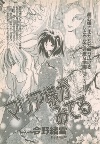



Most Marimite fans probably know that while the anime started in 2004, the series of light novels it's based on began publication in 1998. Many will also be aware of the drama CDs voiced by the anime cast. This page is about what came before the novels and mainstream drama CDs. It's a chance to see and hear Marimite in a very different way from how it ended up. I hope you'll enjoy it!
Disclaimer: The material presented below is copyright Konno Oyuki and/or Shueisha. I'm posting it here as a service to the fan community because it's long since out of print and practically impossible to buy, even second-hand (I got my copies from YJ auctions but it took over a year of hunting). I don't believe this harms the rights-holders' commercial interests, but naturally I'll remove any copyrighted content if they ask me to.
Although the novels start with Yumi and Sachiko just like the anime does, the first story to see print was from what later became the Cherry Blossom arc with Noriko, Shimako and Tōko. As an unrepentant LNFB (Loser Noriko Fan Boy - Okazu readers will understand), this pleases me: not only is Noriko simply wonderful in Cherry Blossom, but I think her Crowning Moment of Awesome is her being there for Tōko in season 4 (if you've watched it you'll know the scene, and if you haven't then you should - here endeth the lesson). Talk about things coming full circle.
The original short story was published as Maria-sama ga Miteru in the February 1997 issue of Cobalt magazine. Konno eventually reworked it as "Cherry Blossom Among the Ginkgo Trees" (銀杏の中の桜 Ichō no Naka no Sakura) and in 2001 it became the first half of the 9th novel, Cherry Blossom. The second half is called BGN (BackGround Noise) and describes the same events from Yumi's perspective - it's a neat way of keeping the original story almost intact while fitting it in to a narrative that barely existed when it was first written.
So how does the story differ from the novel? Most visibly, it's the only one I know of where the art and character designs aren't by Hibiki Reine. Instead it was illustrated by Aoi Yuma (あおい 由麻). The differences in style are quite striking:
By way of comparison, this is how Noriko, Tōko and Sachiko looked in the novel four years later. I haven't been able to find out much about Aoi-san, and of course the Google results are now dominated by this one piece of her work.
The other big difference is that out of the characters we know from the anime, only those mentioned above have names yet (from memory, both Atsuko and Miyuki pop up in the fourth season). The Roses are simply referred to by their colours (e.g. 紅ばらさま "Red Rose-sama" instead of Rosa Chinensis or Sachiko), and while Tōko explains the soeur system pretty much like in the novel, it isn't given that name.
If you want to read the story in its original form you can download it here (12MB zip file). But please support Konno-sensei and buy the novel as well, so you can see how it ended up. Even better, buy them all! There are only 37 - soon to be 38 - to get, and even if you can't read Japanese Hibiki's art really is pretty...
One of the benefits of reading Cobalt is that you can send away for various special presents such as calendars and drama CDs (this only applies if you live in Japan, unfortunately). Since 2004 the annual drama CDs have each included a short Marimite story voiced by the cast from the anime. But on 2003's Tokimeki Drama CD Remix (ときめきドラマCD Remix) we get to hear Sachiko voiced by Kawamura Maria and Yumi by Kuwashima Hōko.
The drama itself is a very short excerpt from the 13th novel, One Page of Midsummer (真夏の一ページ Manatsu no Ichi Pēji), pp81–91. The events here were covered in the second OVA of the third anime season. Here it is as a 2.5MB MP3, or you can download a 3MB zip file that includes relevant bits of the CD liner notes.
While I have no objection to Kawamura-san's interpretation of Sachiko, part of me thinks it would have been cool if they'd chosen Mitsuishi Kotono for the role:
"Onee-sama, I'd like to introduce the representatives of the Hanadera Student Council—no, wait! Onee-sama! Please don't shoot them! You're thinking of the wrong show!"
No disrespect to Aoi-san, but I love Hibiki Reine's character designs and I'm glad Shueisha chose her to illustrate the novels. If nothing else it was a case of good timing: Hibiki was co-winner of the Cobalt 1997 illustration competition, so she got her break just when Konno needed an illustrator. Hibiki's winning picture is in the top left-hand corner of this page of the magazine's December 1997 issue (and here's a close-up if you want to read her comments on winning). The title of the illustration appears to be Angel's Cantarella - who knows, maybe it was the religious imagery that brought her to the attention of Konno's editor?
I've seen Hibiki twice at Comiket (C77 and C78), but both times she
was frantically running around organising her army of assistants at
the Russian Blue booth. Maybe one day when I'm more confident about
speaking Japanese I'll ask her to sign this picture :)
Last update 2010-11-30. Contact webmaster@hikari.org.nz